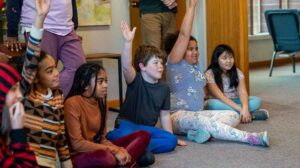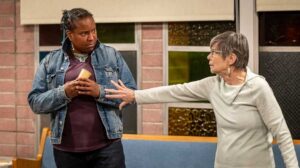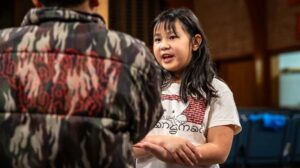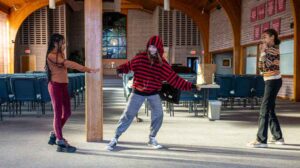A Bright Spot During Trying Times
Shanique Scott brings kids together to learn the art of acting, but it’s much more than that.
Building Something New: Ashland Youth Make Theater Together by Barbara Cervone
It’s the end of a long school day, almost time for dinner, when eleven youngsters, aged 7 to 13, grab a seat in Ashland Public Library’s Stockwell Room.
“Instead of winding down I’m winding up” a girl with a cascading dark updo said to the blond-haired boy next to her. “Me too,” he said.
For the next five days, these elementary and middle-schoolers will “make art” in a theater workshop led by Pam Sterling, an emeritus professor from Arizona State University who has inspired young actors across the country for decades. Joining Sterling are Shanique Scott, a mesmerizing African American actor, director and choreographer who moved to Ashland almost 10 years ago, and Marc Freedman, a former OSF actor now at SOU. A local donor, fond of Scott’s multi-racial theater work with youth, donated frequent flier miles to bring Sterling to town. Ashland Together pledged support as part of its efforts to rethink equity in Ashland, modeling what this might look like across all ages.

“Hi, my name is Pam,” Sterling says to the students now standing in a semicircle in front of her. “What are your names?’”
“Hi, my name is Rosava,” the tallest and oldest member of the group half whispers.
“Here’s the first rule in our work together,” Sterling jumps in. “Speak up and speak clearly.” Rosava tries again.
When it comes to seven-year-old Charlotte, half Rosava’s size, she leaves no doubts about her name. “C-h-a-r-l-o-t-t-e.”
“Now tell us why you are here,” Pam continues, “and tell something about yourself that we wouldn’t know by looking at you.”
A love for performing and theater clearly unites this group. “I’m here because I love every form of theater, acting, musicals, plays,” says Aquila, age 10. “I’m here because I love being with kids who like to act and I like to write plays,” offers Meghan, also 10.
Something we can’t tell by looking at you? Meghan is passionate about engineering. Alex plays the didgeridoo, Aquila, the violin. Mario likes woodworking. Rosava tends gerbils.
Sterling starts leading these young actors through a series of exercises that target the “secret sauce” in the work the students will be doing together: eye contact —the powerful communication tool that allows actors to establish connections between characters without speaking a word.

Devised theater
Rumpelstiltskin — you may have gathered — is not on the playbill here. Sterling, along with Scott, is a champion of a creative alternative called “devised theater” whose roots go back more than a century.
In devised theater, no one knows what the end product will look like—not the performers, nor the creative team. There is no pre-existing script where roles are established. Instead, the performers start with an idea, a question, a piece of music, a set and build something completely new. The work is collaborative and experimental.
As Sterling repeats often as the week unfolds, “There is no right way or wrong way. There are many ways.”
“And I want you to be curious, to wonder about things,” she adds.
Teamwork
When the students enter the education room at the Ashland Food Coop the second night — the group lacks a permanent practice space — a sentence on the white board asks: “What makes a good team?”

Teamwork is the glue that holds devised theater together, Sterling explains. “It requires concentration, cooperation, and communication. It has agreements — that members support each other, no ‘put downs,’ listen to each other and wait their turn.”
“What else makes a team good?” Sterling asks.
She invites participants to take out their notebooks, form small groups, and share thoughts. Five minutes later, the students shower her with ideas which she adds to the agreements on the white board.
Respect each other. Don’t interrupt. Be kind — and disagree kindly. Support each other. Work together to solve a problem. Don’t blame. Contribute, do your part. Don’t rob another person’s work. Share the credit. Don’t say things behind someone’s back. Respect other people’s privacy and confidentiality…
Theater games
This Tuesday night, like every night this week, theater games soon take center stage: warm-ups, team-building exercises, activities that develop imagination, and more.
In “Hand to Hand,” participants divide into pairs and, within pairs, decide who is A and who is B. They must work with together without speaking. Partner A places their hand approximately three inches from partner B’s head and then guides them to move in various ways, using only their hand and never any type of vocalization. The partners then switch roles.
It was hard not to get dizzy watching the slow, gyrating dance between Alex and Emmet (10 and 11) as they paired their movements, swooping, turning, and soaring.

In “Body Parts,” one player stands in the center while everybody else partners up. The player in the middle calls out commands such as “elbow to elbow,” “back to back,” “shoulder to knee.” Players take these positions accordingly. When the person in the middle calls “partner to partner,” all the players have to find a new partner while the person in the middle scrambles for their own. The person left without a partner becomes the new person in the middle and starts to give commands.
“It is is getting awfully personal,” Carina said as she and Mario maneuvered to touch noses as directed.
Bringing it together
On Friday, Carina, Mario and their peers have a new assignment: developing a scene they can perform for their parents the following day. They play a version of a game called “Story Circle,” where people sit in a circle, one starts a story, then passes the storytelling to another person, who passes it on again until everyone has had a turn. The result can be whacky. Gorillas in a jungle may end up in a deep sea submarine.
Today, these blooming thespians, gathered in a circle, throw a ball to one another, taking turns adding to the story after they catch the ball. They end up with a tale about an old man who menaces young children until he is apprehended (successfully or not) by the police. They call the story “Stranger Danger.”
The next morning, the day of the performance, they divide into teams, make a frozen “picture” of three moments in the story they have hatched (interpreting those moments however they wish), and add a few words of dialogue. They weave the moments into a short scene, with their bodies and expressions communicating as much as their words. In one group, we see the old man poisoning two policeman who have been summoned by a distraught child. In another, the old man tries to lure a young brother and sister into his car, and then pays off the policeman who has allegedly come to the rescue.
As the parents take their seats (today at Ashland’s Unitarian Universalist Church), Sterling coaches them on what to expect. Their children will not be delivering lines from a famous play, she tells them, but scenes infused with their own creativity.
“I can’t believe that’s my daughter,” the women next to me says as her child’s group finishes its turn.

Growing
When Shanique Scott moved to Ashland nine years ago, she imagined starting an arts ensemble for diverse, local youth that would foster creativity and collaboration, nourishing theater invention and inclusion alike. In 2023, the “Empowered Arts Ensemble” came to life.
Last spring, the ensemble —a multi-racial group of youth, ages 7 through 12 — performed their first devised theater project, “A Rose that Grew from Concrete,” to standing-room only crowds at Grizzley Peak Winery and SOU’s Black Box Theater. This May, they will present a new work, growing from the extraordinary training Arizona State University’s Pam Sterling provided this January.
“Talented youth creating theater together, celebrating what makes one another special,” says Scott, “it’s a dream come true.”
Ashland Together’s Hillary Larson couldn’t agree more. “Watching Shanique and her young acting troupe exercise their creativity, with a mix of collaboration and mutual respect…it’s impossible not to smile.”
At the end of their performance before parents and friends, Sterling demonstrated how to bow with feeling. On cue, the young actors joined hands, raised their arms to the sky, and bent their bodies towards the floor. “Bravo,” their parents cheered.
For more information, contact Shanique Scott, Empowered Arts Ensemble, shash1975@yahoo.com.
This article by Barbara Cervone is also a contribution to Ashland.news as part of their commitment to their “Unheard Voices” initiative.
